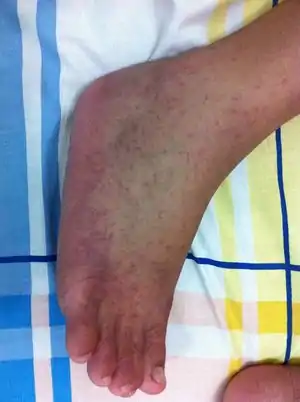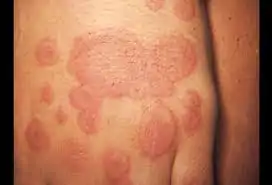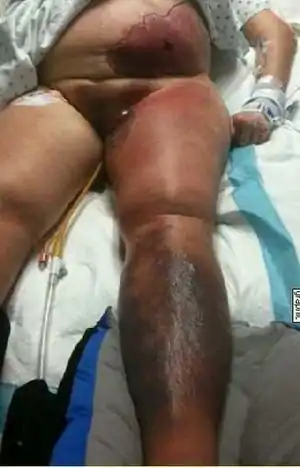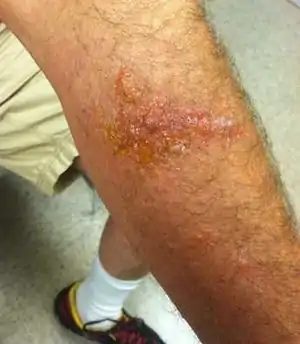General approach to rashes
This page is for adult patients; for other age groups see pediatric rashes and neonatal rashes
Background

3D medical illustration showing major layers of skin
- A wide range of benign and dangerous pathology can present with a rash
Rash Red Flags[1]
- Fever
- Toxic appearance
- Hypotension
- Mucosal lesions
- Severe pain
- Very old or young age
- Immunosuppressed
- New medication
Small lesions (<0.5cm)
| Name | Raised/Palpable | Fluid-Filled | Other Description | Diagram |
| Macule | No | None | flat, cirumscribed, colored |  |
| Papule | Yes | None | Solid |  |
| Vesicle | Yes | Clear | .png.webp) | |
| Pustule | Yes | Pus | Leukocytes or keratin |  |
Large lesions (>0.5cm)
| Name | Raised/Palpable | Fluid-Filled | Other Description | Diagram |
| Patch | No | None | Large macule (flat, colored) |  |
| Plaque | Yes | None | Superficially raised, circumscribed solid area |  |
| Nodule | Yes | None | Distinct large papule |  |
| Bulla | Yes | Clear | Large vesicle/blister or exposed epidermal layer |  |
| Wheal | Yes | Edema | Firm and edema of dermis |
Other

Ulcer, fissue, and erosion
- Plaque/scaley papule
- Eschar
- Fissure/erosion/ulcer
- Purpura/petechia
- Plaque/smooth papule
Clinical Features
History
- Key elements from the history include:
- Distribution and progression of the skin lesions
- Recent exposures (sick contacts, foreign travel, sexual history and vaccination status)
- Any new medications
Physical Exam
- Pay specific attention to vital signs
- A rash associated with fever or hypotension should make you worry about potentially deadly diagnoses
- Perform a careful physical exam
- Undressing the patient to fully examine the trunk and the extremities
- Look at palms, soles and mucous membranes
- Touch the skin with a gloved hand to determine if the lesions are flat or raised
- Press on lesions to see whether they blanch
- Rub erythematous skin to see if it sloughs
Differential Diagnosis
Rash
- Acute generalized exanthematous pustulosis
- Allergic reaction
- Aphthous stomatitis
- Atopic dermatitis
- Chickenpox
- Chikungunya
- Coxsackie
- Dermatitis herpetiformis
- Erysipelas
- Exfoliative erythroderma
- Impetigo
- Measles
- Miliaria (Heat Rash)
- Necrotizing fasciitis
- Pellagra
- Poison Oak, Ivy, Sumac
- Psoriasis
- Pityriasis rosea
- Scabies
- Seborrheic dermatitis
- Serum Sickness
- Smallpox
- Shingles
- Tinea capitus
- Tinea corporis
- Vitiligo
Vesiculobullous rashes
Febrile
- Diffuse distribution
- Localized distribution
Afebrile
- Diffuse distribution
- Bullous pemphigoid
- Drug-Induced bullous disorders
- Pemphigus vulgaris
- Phytophotodermatitis
- Erythema multiforme major
- Bullous impetigo
- Localized distribution
- Contact dermatitis
- Herpes zoster
- Dyshidrotic eczema
- Burn
- Dermatitis herpetiformis
- Erythema multiforme minor
- Poison Oak, Ivy, Sumac dermatitis
- Bullosis diabeticorum
- Bullous impetigo
- Folliculitis
Petechiae/Purpura (by cause)
- Abnormal platelet count and/or coagulation
- Septicemia
- Idiopathic thrombocytopenic purpura (ITP)
- Hemolytic uremic syndrome
- Leukemia
- Coagulopathies (e.g. hemophilia)
- Henoch-Schonlein Purpura (HSP)
- Acute hemorrhagic edema of infancy (AHEI)
- Hypersensitivity vasculitis
- Primary vasculitides
- Wegener's
- Microscopic polyangiitis
- Eosinophilic granulomatosis with polyangiitis (Churg-Strauss syndrome)
- Secondary vasculitides
- Henoch-Schonlein purpura
- Connective tissue disorder
- Scurvy
- Infectious disease
- Trauma
Erythematous rash
- Positive Nikolsky’s sign
- Febrile
- Staphylococcal scalded skin syndrome (children)
- Toxic epidermal necrolysis/SJS (adults)
- Afebrile
- Febrile
- Negative Nikolsky’s sign
- Febrile
- Afebrile
- Anaphylaxis
- Scombroid
- Alcohol intoxication
- Exfoliative erythroderma
- Cellulitis
- Drug rash
- Erythema multiforme
- Dermatitis (eczema)
Evaluation

Rash visual diagnosis







 Coxsackie
Coxsackie

 Henoch-schonlein purpura
Henoch-schonlein purpura Hives
Hives


 Miliaria (Heat Rash)
Miliaria (Heat Rash) Nectrotizing fasciitis
Nectrotizing fasciitis
 Poison ivy/Oak/Sumac
Poison ivy/Oak/Sumac Poison ivy/Oak/Sumac
Poison ivy/Oak/Sumac

 Psoriasis before and after treatment.
Psoriasis before and after treatment.

 Seborrheic dermatitis
Seborrheic dermatitis Shingles
Shingles Steven Johnson syndrome
Steven Johnson syndrome



Vesiculobullous rashes visual diagnosis

 Bullous impetigo (after the bulla have broken)
Bullous impetigo (after the bulla have broken)


 Gonococcal
Gonococcal



 Nectrotizing fasciitis
Nectrotizing fasciitis

Management
- Based on diagnosis
Disposition
- Based on diagnosis
See Also
References
- Nguyen T and Freedman J. Dermatologic Emergencies: Diagnosing and Managing Life-Threatening Rashes. Emergency Medicine Practice. September 2002 volume 4 no 9.
This article is issued from Wikem. The text is licensed under Creative Commons - Attribution - Sharealike. Additional terms may apply for the media files.




_Skin_Syndrome_-_Feet_Collage.jpg.webp)






